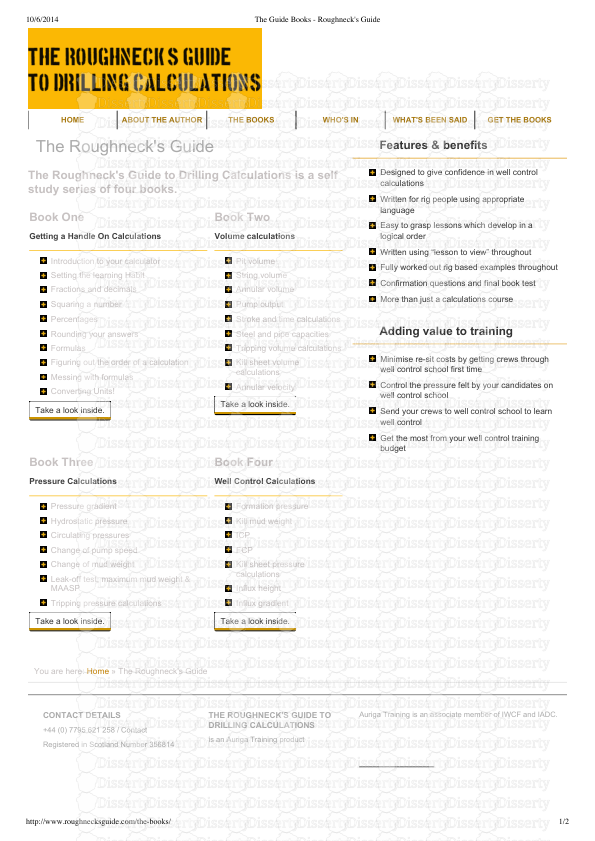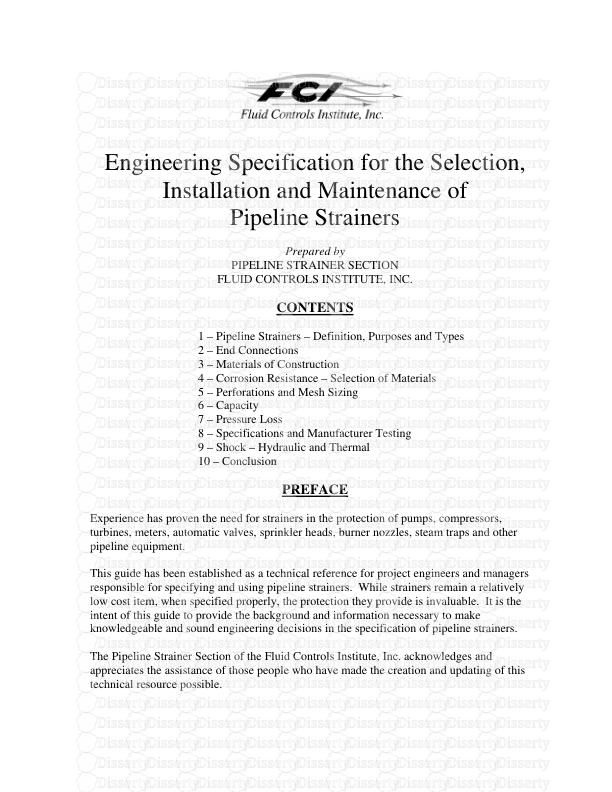Engineering Specification for the Selection, Installation and Maintenance of Pi
Engineering Specification for the Selection, Installation and Maintenance of Pipeline Strainers Prepared by PIPELINE STRAINER SECTION FLUID CONTROLS INSTITUTE, INC. CONTENTS 1 – Pipeline Strainers – Definition, Purposes and Types 2 – End Connections 3 – Materials of Construction 4 – Corrosion Resistance – Selection of Materials 5 – Perforations and Mesh Sizing 6 – Capacity 7 – Pressure Loss 8 – Specifications and Manufacturer Testing 9 – Shock – Hydraulic and Thermal 10 – Conclusion PREFACE Experience has proven the need for strainers in the protection of pumps, compressors, turbines, meters, automatic valves, sprinkler heads, burner nozzles, steam traps and other pipeline equipment. This guide has been established as a technical reference for project engineers and managers responsible for specifying and using pipeline strainers. While strainers remain a relatively low cost item, when specified properly, the protection they provide is invaluable. It is the intent of this guide to provide the background and information necessary to make knowledgeable and sound engineering decisions in the specification of pipeline strainers. The Pipeline Strainer Section of the Fluid Controls Institute, Inc. acknowledges and appreciates the assistance of those people who have made the creation and updating of this technical resource possible. CHAPTER 1 Definition A pipeline strainer is a device which provides a means of mechanically removing solids from a flowing fluid. This is accomplished by utilizing a perforated metal, mesh or wedge wire straining element. The most common range of strainer particle retention is 1” to 40 micron (0.0016”). Purpose Strainers are employed in pipelines to protect downstream mechanical equipment such as condensers, heat exchangers, pumps, compressors, meters, spray nozzles, turbines, and steam traps from the detrimental effect of sediment, rust, pipe scale, or other extraneous debris. Types of Strainers Specified strainers are the Y strainer and the basket strainer. While there is primarily one type of Y strainer (Fig. 1A), there are several variations of basket strainers (Figs. 1B through 1D). Figure 1A Figure 1B Figure 1C Figure 1D Y Strainer, Basket Strainer Vertical piping, frequently found at pump inlets, necessitates the use of a Y strainer or a tee type basket strainer. Most basket strainers are intended for horizontal or slightly inclined piping. Special attention must be given to the orientation of the debris collection chamber and the drain (blowdown) connection of the strainer. The strainer must be installed such that 2 it is located at the lowest possible position (Fig. 2). For liquid flow a Y strainer in vertical piping must be placed with its screen in the downward position to trap the sediment in the debris collection chamber. For steam service, it is recommended that Y strainers be mounted sideways in horizontal lines to prevent condensate accumulation. Liquid Flow Figure 2 Tee type strainers, suction diffusers and several variations of basket strainers can also be used in a right angle flow application (Fig. 3). Figure 3 Y strainers and most variations of basket strainers can be self-cleaning. With the addition of a blowdown valve and some modification of the straining element of a basket strainer, the element can be flushed out by opening and closing the blowdown valve. This can be accomplished without flow stoppage or disassembling any piping. In sizes above 4”, a single basket strainer will generally create less pressure drop than a Y strainer. Basket strainers are normally installed in a horizontal pipeline with the cover over the basket at the top. Cleaning of the strainer is generally simple and no draining is required. Cover flanges for basket strainers are relatively easy to remove and servicing is simple. Replacement of covers is facilitated by some manufacturers through the use of studs, rather than bolts, which help to align the cover during the replacement operations. Hinged covers and screen locking devices can also make servicing easier. 3 There seems to be a general misconception among engineers and contractors concerning Y strainers and basket strainers used in steam service. In many instances, basket and Y strainers will perform comparably in steam service. It is essential in ordering strainers for steam service that the manufacturer be so advised. As mentioned above, the housings may be furnished with a special bottom, allowing the accumulated debris to be blown out by opening the blowdown valve (Fig. 4). Figure 4 While there are some high pressure applications for basket strainers, (Fig. 5), due to the required thickness and subsequent high cost, basket strainers are not normally constructed for pressures above 1 500 psi. Y strainers, on the other hand, are readily available for working pressures of 6 000 psi and higher. In addition to Y and basket types, other strainers are 4 5 available such as duplex/twin, temporary/geometric, washdown/back-flushing, automatic self cleaning, plate or expanded cross section type, and scraper types. Descriptions of these as well as miscellaneous options available with them follow. Figure 5 Duplex/Twin Strainers For applications where continuous operation is required and the line cannot be shutdown for cleanout, duplex or twin (dual) basket strainers can be used. Refer also to Automatic Strainers for continuous service applications. Examples are fuel oil strainers for industrial or marine oil burners, lubricating lines on ships, cooling towers, continuously running chemical operations, and many industrial water intake and service lines. When one basket becomes full, the flow is switched to the other basket. The first basket is removed, cleaned and replaced. For smaller sizes the plug-type or ball-type duplex basket strainer (Fig. 6) is generally used since it is less costly to construct, and simpler to operate and maintain than other types. It is basically two connected valves with two integral basket wells into which flow can be diverted by rotating the handle. Figure 6 6 Twin (dual) basket strainers, two single basket strainers connected in parallel with individual control valves, are also available (Fig. 7). It occupies more space than a duplex strainer. However, because of the more circuitous path the liquid must take through a duplex strainer, pressure drop is higher than through the equivalent size single or twin basket strainer. Figure 7 Temporary (Geometric) Strainers Where cost is of prime importance, a temporary strainer may be installed between flanges in a pipeline. Variations of temporary strainers include cone (Fig. 8A), truncated cone (Fig. 8B) and flat (Fig. 8C) geometries. The design considerations with these types of strainers are: 1. They have a lower net open area than basket strainers. 2. The pipeline must be disassembled to inspect, clean or remove these strainers. 3. Structural strength can be difficult to achieve, particularly in larger sizes, and in the case of wire mesh. Figure 8A Figure 8B Figure 8C While these strainers were once used only temporarily or for startup, frequently they are now left in the line during operation. As with all types of strainers, periodic maintenance must be carried out to ensure efficient operation. 7 Washdown, Manual, Fixed or Rotary Spray, Back-Flushing Strainers These strainers are fitted with side inlets or other devices for the introduction of high velocity liquid (the same as being strained – usually water). The velocity of the water and the turbulence created back-flush the strainer basket and opening a drain valve evacuates the debris (Fig. 9). Figure 9 Automatic Self-Cleaning Strainers An automatic self-cleaning strainer is a unit which goes through a complete cleaning cycle, using some of the fluid flowing through the strainer to flush out the collected debris, with little or no attention by the plant personnel. There are numerous styles of automatic strainers produced and each has its desirable features; however, only a limited discussion is presented in this article. Figure 10 is an example of basic types of automatic self-cleaning strainers. Automatic strainers are normally more expensive than the manually cleaned units but their extra cost can often be justified by one or more of the following reasons: 1. The frequency of cleaning of a manual unit and the cost of labor for doing this. 2. If there is any danger that the strainer or the equipment that it is protecting may be damaged by the strainer not being cleaned when required. 3. The strainer is necessarily located in a place where it is not readily accessible for cleaning. 4. Plugging of the strainer is unpredictable due to a variable loading rate such that manual cleaning cannot be properly scheduled. 5. Insufficient available personnel to perform the manual cleaning. 8 Figure 10 There are many types of automatic and semi-automatic controls for the strainer. Among these are: 1. Differential pressure switch which senses the pressure drop across the strainer and initiates a cleaning cycle at a preset pressure differential. 2. Timer which initiates cleaning cycle of strainer at preset intervals of time. 3. Pushbutton start for which an operator pushes a button to initiate a cleaning cycle (semi-automatic). 4. Differential pressure switch alarms which signal the operator that the strainer needs cleaning (semi-automatic). 5. Any combination of the above controls. All of the above control systems are normally used with strainers that clean intermittently. Some automatic strainers also clean uploads/Voyage/ strainer-guide.pdf
Documents similaires








-
15
-
0
-
0
Licence et utilisation
Gratuit pour un usage personnel Attribution requise- Détails
- Publié le Jan 08, 2021
- Catégorie Travel / Voayage
- Langue French
- Taille du fichier 1.4221MB


